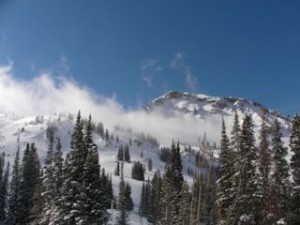
For skiers and boarders in the UK, one major question is where to head on a ski trip – short haul to Europe, or long haul to North America? While the US and Canada are often thought of as having better the snow, the start of this 2011/12 season has shown that this isn’t necessarily the case, with the nearly Alps drowning in powder over Christmas while Colorado wait desperately for a big storm to kick off their season (edit – it looks like it’s arrived!). So, snowfall aside, here is snowgenius.com’s list of key factors to determine whether to head west or south…
North American Strengths
- Space – probably the key reason for choosing the US or Canada over Europe is the lack of crowds out west. For anyone who has ever tackled a busy piste on a holiday week in France, the resorts of North America are almost unbelievably empty – Sometimes you can quite literally have a whole section of the mountain to yourself. Even on supposedly busy holiday weekends when the locals will warn you it is going to be “crazy”, it never approaches the carnage that can unfold sometimes in Europe.
- Accessible powder – As set out above, we’re not going to rate either side of the pond based on its snowfall, given how quickly that can change. What is true though is that North America’s approach to opening terrain makes it easier for the average skier to hit the powder when it’s available. In the US and Canada, all the ski areas have the concept of “in bounds” terrain, which is all avalanche-controlled and patrolled, but includes ungroomed as well as groomed slopes. In general, you’re free to explore the in bounds terrain at will, and don’t need to take the precautions that you would in Europe (shovel, probe, transceiver and training).
- Roadtrips – The setup of most (but not all) North American resorts is to have the accommodation to a little way from the mountain – people tend to drive or bus up to the slopes each day. If you’ve got a car anyway, this makes it very easy to string together a roadtrip, taking in a number of resorts in a single holiday. Indeed, you can even stay totally flexible and chase the snow, finding accommodation as you to. Plus, if you hire the right car you get to cruise around in an enormous 4×4 SUV!
European strengths
- Après ski – Don’t get us wrong, there is plenty of great après ski in North America. However, with a few notable exceptions, it tends to be a bit quieter than in Europe, in part probably because people tend to drive to and from the ski areas. If you’re looking for full throttle, ski boot dancing on the tables, Jägerbombs at 4pm-style après, you want to go to Europe, or more specifically, Austria (or more specifically still, the Mooserwirt…!)
- Pretty villages – Again, this is a generalisation, and there are some gorgeous ski towns in the US with a real sense of heritage (think Aspen or Breckenridge). However, these tend to be sadly outnumbered by rather charmless shopping-mall style base areas, or worse, fake Tyrolean village setups (we’re looking at you, Vail). Once you’re up on the mountain who cares, but if you’re looking for chocolate box village scenery, Europe is generally better (though of course it also has its share of concrete 1960s horrors, especially in France).
- Mountain food – This comes down to a difference in attitude really, and again is a generalisation to which there are exceptions. But overall it tends to hold true – in North America, lunch is about refuelling, grabbing a quick bite to eat and getting back on the snow. In Europe, there are quite a lot of people for whom lunch is the main purpose of a day skiing – sitting on a terrace in the sunshine with a bottle of wine and watching the world ski by. Personally, we much prefer to ski, but if you’re a member of the long lunch brigade, stick to Europe.
One of the seemingly obvious differences for skiers in the UK is that it must cost more and take longer to get to North America than Europe. At a basic level that must be true – the cheapest trip to Europe is always going to be less than going to North America, and with a minimum flight time of 9-10 hours to reach (say) Colorado, clearly it takes longer.
However, when you dig down a bit, these differences can be less stark than they seem. The 7 hour time difference between the UK and Colorado means that if you leave London on Saturday morning, you should still arrive at your ski resort by early evening local time, ready to ski the next day. Granted the time difference means you lose time on the return trip – but what were you going to so with that Saturday evening anyway when you’re knackered after skiing?! Meanwhile getting to the Alps can sometimes take longer than expected, once you factor in long and sometimes delayed transfers.
As for costs, it is definitely the case that once you are there, everything (apart, oddly from ski passes) is cheaper in North America than in Europe. So you tend to save money on lunch, après ski and dining out. Add into the mix the chance to pick up some new ski gear at a lower price, and you start to recoup the extra costs of the flights. As a totally non-scientific estimate, we reckon that the average trip to North America costs 20-30% more than the equivalent European trip. Depending on how you like your skiing, that might or might not be a price worth paying…
[fbcomments]

